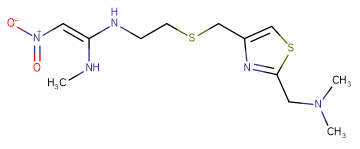
Nizatidine
CAS No. 76963-41-2
Nizatidine ( LY139037 )
Catalog No. M15911 CAS No. 76963-41-2
Nizatidine is a histamine H2 receptor antagonist with low toxicity that inhibits gastric acid secretion.
Purity : >98%(HPLC)
 COA
COA
 Datasheet
Datasheet
 HNMR
HNMR
 HPLC
HPLC
 MSDS
MSDS
 Handing Instructions
Handing Instructions
| Size | Price / USD | Stock | Quantity |
| 100MG | 37 | In Stock |


|
| 1G | 49 | In Stock |


|
Biological Information
-
Product NameNizatidine
-
NoteResearch use only, not for human use.
-
Brief DescriptionNizatidine is a histamine H2 receptor antagonist with low toxicity that inhibits gastric acid secretion.
-
DescriptionNizatidine is a histamine H2 receptor antagonist with low toxicity that inhibits gastric acid secretion.
-
SynonymsLY139037
-
PathwayEndocrinology/Hormones
-
TargetAChR
-
RecptorAChE; H2 receptor
-
Research AreaInflammation/Immunology
-
Indication——
Chemical Information
-
CAS Number76963-41-2
-
Formula Weight331.46
-
Molecular FormulaC12H21N5O2S2
-
Purity>98%(HPLC)
-
SolubilityEthanol: 18 mg/mL (54.3 mM); Water: 28 mg/mL (84.47 mM); DMSO: 66 mg/mL (199.11 mM)
-
SMILESCN/C(NCCSCC1=CSC(CN(C)C)=N1)=C\[N+]([O-])=O
-
Chemical Name(E)-N-(2-(((2-((dimethylamino)methyl)thiazol-4-yl)methyl)thio)ethyl)-N-methyl-2-nitroethene-1,1-diamine
Shipping & Storage Information
-
Storage(-20℃)
-
ShippingWith Ice Pack
-
Stability≥ 2 years
Reference
1.Lin TM, et al. J Pharmacol Exp Ther, 1986, 239(2), 406-410.
molnova catalog


related products
-
Gallamine triethiodi...
Gallamine Triethiodide is a synthetic nondepolarizing blocking drug.
-
Apilimod mesylate
Apilimod mesylate is a potentIL-12/IL-23inhibitor.
-
Carbaryl
A carbamate insecticide and parasiticide. It is a potent anticholinesterase agent belonging to the carbamate group of reversible cholinesterase inhibitors.



 Cart
Cart
 sales@molnova.com
sales@molnova.com


